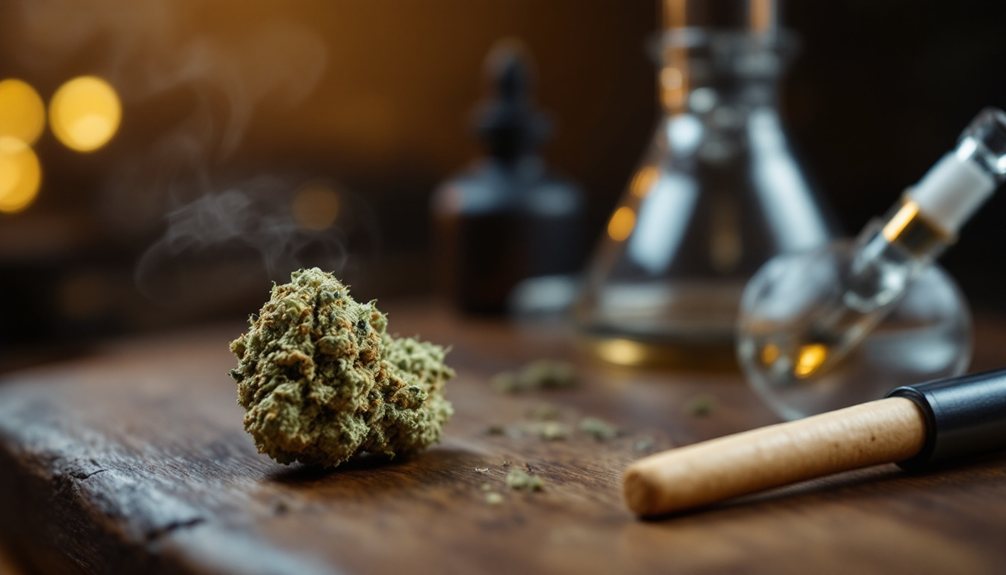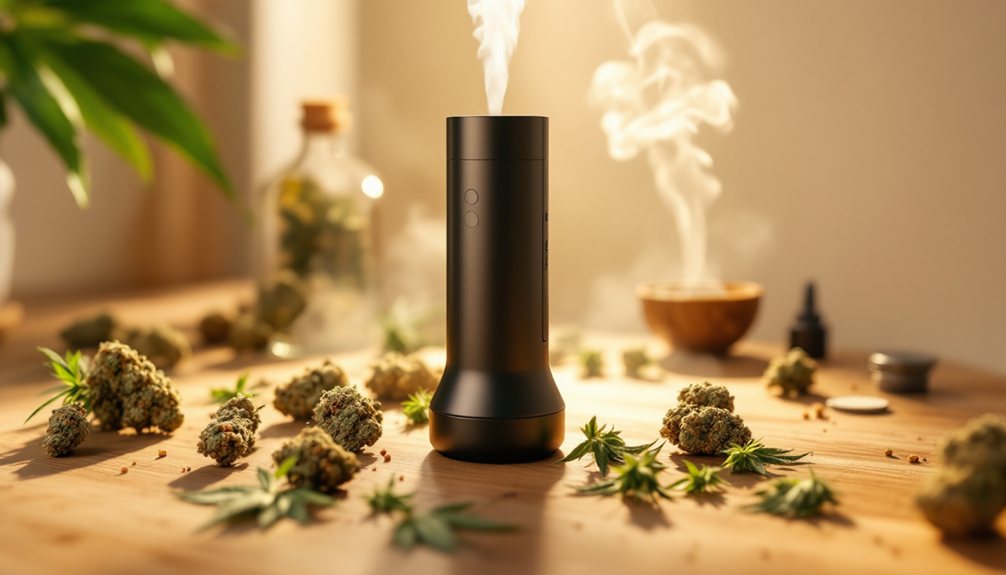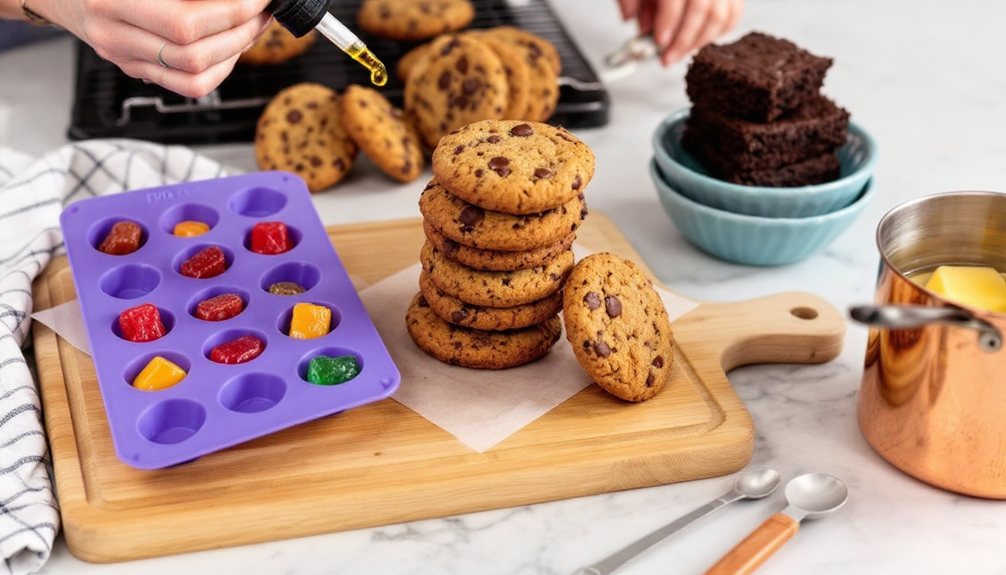You’ll find multiple ways to consume cannabis beyond traditional smoking methods. Joints and pipes offer quick effects, while vaporizers provide a smoke-free experience. Edibles deliver longer-lasting results but require careful dosing, starting at 2.5-5mg THC. Tinctures allow precise control through sublingual application, and concentrates pack powerful effects for experienced users. Understanding each method’s unique characteristics will help you make informed choices for a safe, enjoyable experience.
Expert Highlights
- Traditional smoking methods like joints and pipes offer immediate effects and easier dosage control for beginners.
- Vaporization provides a gentler alternative to smoking, with temperature control affecting the intensity of effects.
- Edibles produce longer-lasting effects but require careful dosing, starting at 2.5-5mg THC and waiting two hours before more.
- Tinctures offer precise dosing through sublingual application, with effects typically felt within minutes.
- Start with familiar consumption methods in a comfortable environment, keeping detailed notes about dosage and personal reactions.
Traditional Smoking Methods: Joints, Pipes, and Bongs

Most cannabis users begin their journey with traditional smoking methods, which remain popular due to their simplicity and accessibility.
Joints consist of ground cannabis rolled in thin papers, offering portability and easy sharing.
You’ll find basic pipes made of glass, metal, or wood that provide quick, direct consumption through a small bowl and mouthpiece.
Bongs filter smoke through water, delivering smoother hits and reducing harshness.
You’ll want to fill the chamber with clean water, pack the bowl with ground flower, and inhale steadily as the smoke builds.
These methods let you control your dosage while experiencing immediate effects.
For the best experience, look for craft flower sourced from high-performing genetics that ensures premium quality and potency.
Modern Vaporization: A Smoke-Free Alternative

When you’re exploring vaporization, you’ll find two main options: dry herb vaporizers that heat cannabis flower and concentrate vaporizers that heat extracts like oils or waxes.
With dry herb vaporizers, you’ll pack ground cannabis directly into the heating chamber, while concentrate devices require you to load specially processed cannabis extracts.
Your vaporizer’s temperature settings will determine both vapor production and which compounds are released, with lower temperatures producing lighter effects and higher temperatures delivering more intense results.
Dry Herb Vs Concentrate
Everyone seeking a smoke-free cannabis experience should consider modern vaporization methods, which offer two distinct options: dry herb and concentrate vaping. Understanding the differences will help you choose the right method for your needs.
| Feature | Dry Herb | Concentrate |
|---|---|---|
| Material | Ground flower | Oil, wax, shatter |
| Potency | 15-25% THC | 60-90% THC |
| Setup Time | Grinding required | Ready to use |
| Duration | 10-15 sessions | 20-30 sessions |
| Cost | $8-15/gram | $30-60/gram |
Dry herb vaping preserves the plant’s full spectrum of compounds, while concentrates deliver precise, potent doses. Your choice depends on your desired effects, budget, and convenience preferences.
Temperature Control Basics
Temperature control stands as an essential factor in vaporization, allowing you to access specific compounds and flavors from cannabis without combustion.
Different cannabinoids and terpenes activate at varying temperatures, giving you precise control over your experience.
For ideal results, start at lower temperatures (320-350°F) to preserve delicate terpenes and experience subtle flavors.
Mid-range temperatures (350-385°F) release more cannabinoids while maintaining flavor.
Higher temperatures (385-430°F) produce stronger effects but risk harsh vapor.
You’ll want to adjust these ranges based on your device, material quality, and desired effects.
Remember that exceeding 430°F approaches combustion territory.
Edibles and Culinary Cannabis Products

When exploring edible cannabis products, you’ll need to understand proper dosing since these items can produce stronger and longer-lasting effects than other consumption methods.
You should store edibles in clearly labeled, child-proof containers away from regular food items to prevent accidental consumption.
Whether you’re trying cannabis-infused chocolates, gummies, beverages, or baked goods, start with a small dose and wait at least two hours before consuming more.
Dosing for Optimal Effects
Learning how to properly dose cannabis edibles is essential for achieving desired effects while avoiding uncomfortable experiences. When you’re new to edibles, start with a low dose and wait at least two hours before consuming more. The delayed onset can lead to overconsumption if you’re not patient.
- Begin with 2.5-5mg THC per serving to gauge your tolerance.
- Keep a consumption journal to track your ideal dosage and timing.
- Consider the ratio of THC to CBD, as higher CBD content can help moderate psychoactive effects.
Remember that factors like metabolism, food intake, and individual biochemistry influence how edibles affect you.
Safety and Storage Tips
Proper storage and safety practices for cannabis edibles can protect both you and others in your household from accidental consumption or product degradation. Always store your cannabis products in airtight, child-resistant containers away from direct light and heat. Label everything clearly with potency and dates.
| Storage Do’s | Storage Don’ts |
|---|---|
| Use airtight containers | Leave products exposed |
| Store in cool, dark place | Store near heat sources |
| Label clearly | Mix with regular foods |
Keep edibles in their original packaging when possible, and store them separately from regular food items to prevent confusion. Remember to wash your hands and clean preparation surfaces thoroughly after handling cannabis products.
Common Types of Edibles
Today’s cannabis edibles market offers an extensive variety of products that go far beyond the traditional pot brownie.
You’ll find innovative culinary creations that cater to different dietary preferences and taste preferences, making it easier to integrate cannabis into your wellness routine.
- Sweet treats: Gummies, chocolates, cookies, and candies offer precise dosing and convenient consumption.
- Beverages: Cannabis-infused drinks including sodas, teas, and sparkling waters provide a smokeless alternative.
- Savory options: Chips, crackers, nuts, and cooking oils allow you to incorporate cannabis into regular meals.
These diverse options let you choose products that best suit your clients’ needs and preferences.
Tinctures and Sublingual Applications
While traditional smoking methods remain popular, cannabis tinctures and sublingual applications offer a discreet and precise way to consume cannabinoids.
You’ll find these liquid extracts in small bottles with droppers, making dosage control straightforward and accurate.
To use tinctures, place the drops under your tongue and hold for 30-60 seconds before swallowing.
The cannabinoids absorb directly into your bloodstream through the sublingual tissue, providing faster effects than edibles. Tinctures can also be added to beverages or food.
Sublingual absorption through tissues under the tongue allows faster delivery into the bloodstream compared to digesting edibles.
When serving others, recommend starting with a low dose of 2-3 drops to assess individual tolerance and sensitivity.
Topicals and Cannabis-Infused Skincare
Cannabis-infused topicals represent a unique consumption method that doesn’t produce psychoactive effects, making them popular among users seeking localized relief. These products work by binding to cannabinoid receptors in your skin, muscles, and joints, delivering targeted benefits without entering your bloodstream.
- Choose from balms, lotions, oils, and patches designed for specific needs like muscle soreness, joint pain, or skin conditions.
- Apply topicals directly to clean, dry skin and massage gently until absorbed.
- Start with a small amount and reapply as needed, typically every 4-6 hours.
Most topicals contain CBD, THC, or both, often combined with other beneficial ingredients like essential oils and herbs.
Concentrates and Dabbing Essentials
Because concentrates deliver potent cannabinoids in their purest form, they’ve become increasingly popular among experienced cannabis users. Dabbing requires specific tools and techniques to heat and vaporize these potent extracts properly. You’ll need a dab rig, torch, and dabbing tool to get started.
| Equipment | Purpose |
|---|---|
| Dab Rig | Specialized water pipe for concentrates |
| Torch | Heats the banger or nail |
| Carb Cap | Controls airflow and temperature |
| Dabbing Tool | Applies concentrate to heated surface |
Start with small amounts, as concentrates can be 60-90% THC, much stronger than traditional flower’s 15-25%.
Safety Guidelines and Best Practices for New Users
The introduction of any new substance requires careful attention to safety protocols and responsible consumption habits.
Safety first: approaching any unfamiliar substance demands thoughtful protocols and measured consumption to ensure wellbeing.
When exploring cannabis consumption, you’ll want to prioritize safety while discovering what works best for you.
- Start with low doses (5mg THC or less) and wait at least 2 hours before consuming more to understand your tolerance.
- Create a comfortable, safe environment with trusted friends and guarantee you have transportation arranged.
- Keep track of your experiences in a journal, noting strains, dosages, and effects to develop awareness of your personal reactions.
Frequently Asked Questions
How Does Cannabis Affect Different People Based on Their Body Weight?
Your body weight influences cannabis effects – if you’re lighter, you’ll typically need less to feel effects, while heavier individuals may require more for similar results due to metabolism differences.
Can You Develop a Permanent Tolerance to Cannabis Over Time?
You won’t develop permanent tolerance to cannabis – taking breaks can reset sensitivity. Your tolerance builds with regular use but returns to baseline after a brief tolerance break.
What Medical Conditions Can Disqualify Someone From Safely Using Cannabis?
You shouldn’t use cannabis if you have heart problems, psychosis, pregnancy, severe anxiety, unstable blood pressure, or liver disease. Always check with your doctor about potential medication interactions.
How Do Prescription Medications Interact With Different Cannabis Consumption Methods?
You’ll need to consult your healthcare provider about drug interactions, as cannabis can affect medications’ metabolism. Different consumption methods may impact how strongly these interactions occur.
Does the Time of Day Impact the Effectiveness of Cannabis Use?
You’ll notice different effects based on when you consume cannabis. Morning use may increase alertness, while evening consumption often promotes relaxation and better sleep due to your body’s natural rhythms.
Expert Final Thoughts
Whether you’re exploring traditional smoking, trying modern vaporizers, sampling edibles, or experimenting with tinctures and topicals, you’ve got plenty of options for cannabis consumption. Take time to find what works best for you, start low and go slow, and always prioritize safety. Remember to check your local laws and consult healthcare providers before beginning your cannabis journey.





Join the Discussion